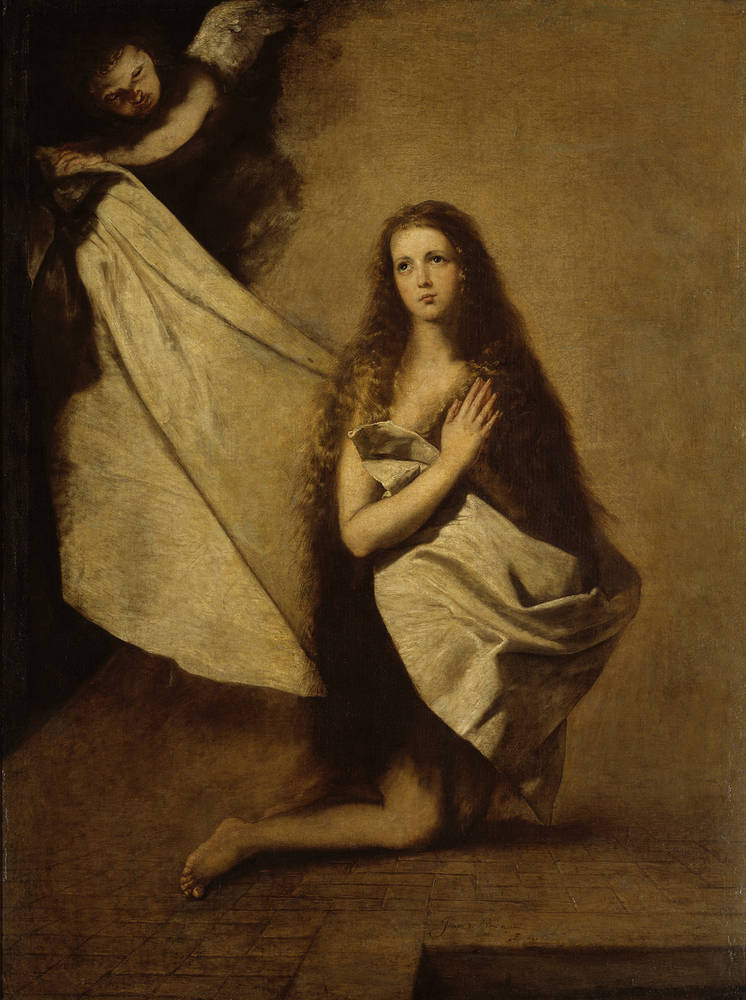log in
Enter site
Login to use Arthive functionality to the maximum
Holy Inessa
Jose de Ribera • Painting, 1641, 152×203.5 cm
Description of the artwork «Holy Inessa»
"The Holy Inessa" stored in the gallery of Dresden, is considered to be one of the best paintings of the late Jose Ribera.
"The Holy Inessa" H. de Ribera: the details of the plot
The life of this Saint is very unusual. She was young and beautiful Roman woman, daughter of wealthy parents. Secret from family, she converted to Christianity. For this she was sentenced to decapitation. Her tormentors were inventive: in their eyes, to the place of execution she had to proshestvovali naked. She walked through the excited crowd, devoured by thousands of greedy eyes. She stumbled when she pushed the lustful hands of the guards. But God, for the faith in which she was on the chopping block, still heard the supplication to save her if not death, then at least from shame. Instantly regrown hair and the white veil, my angel from heaven, hid her nakedness from the crowd raging.
"The Holy Inessa" H. de Ribera: design and composition
Interestingly, the painting is not the place of the Roman plebs, while the dynamic multi-figure compositions (e.g., crowd, cruel pleasure those who crucified Saint Bartholomew) well-managed Ribera. Obviously, there is a welcome engagement: all gawking at Inessa should be placed in the same place and look Holy at the same angle as the audience. The viewer, thus, from the passive observer turns into an unwitting accomplice to all that is happening with Inessa.
Apparently, Ribera in this case are not interested in the juxtaposition of the Christian Holy – sinful world, but only the depth of the internal state of the Inessa. It is important to convey her innocence, her childish poignancy. To achieve this goal, the Ribera makes the background blurry and the maximum of the conditional, and the figure of the INES, on the contrary, writes very carefully. We can see the following details: separate the fluffy strands of her hair, silvery eyes tear, imbued with pink light slim fingers. They are all written with sasemas a reality.
"The Holy Inessa" H. de Ribera: features color
One of the main advantages of the "Santa INES" – its flavor. It was created in a time when Ribera refused sharp black and white contrasts, and the palette of his paintings became lighter and balanced.
There is a certain paradox: many of the paintings of the artist (and "the Holy Inessa" in particular) seem almost monochrome, forcing to remember about the notorious "Spanish gloom", while Ribera is one of the best colorists of his time. What's the deal here? Probably in the "fifty shades of grey" in the works of Ribera. The incredible richness of colours and reflexes, each of which even have a separate title – a variety of vaguely-brown, silver-grey, grey-pink and brownish-green – makes connoisseurs to admire the magnificent and powerful tone painting of Ribera.
Author: Anna Yesterday
"The Holy Inessa" H. de Ribera: the details of the plot
The life of this Saint is very unusual. She was young and beautiful Roman woman, daughter of wealthy parents. Secret from family, she converted to Christianity. For this she was sentenced to decapitation. Her tormentors were inventive: in their eyes, to the place of execution she had to proshestvovali naked. She walked through the excited crowd, devoured by thousands of greedy eyes. She stumbled when she pushed the lustful hands of the guards. But God, for the faith in which she was on the chopping block, still heard the supplication to save her if not death, then at least from shame. Instantly regrown hair and the white veil, my angel from heaven, hid her nakedness from the crowd raging.
"The Holy Inessa" H. de Ribera: design and composition
Interestingly, the painting is not the place of the Roman plebs, while the dynamic multi-figure compositions (e.g., crowd, cruel pleasure those who crucified Saint Bartholomew) well-managed Ribera. Obviously, there is a welcome engagement: all gawking at Inessa should be placed in the same place and look Holy at the same angle as the audience. The viewer, thus, from the passive observer turns into an unwitting accomplice to all that is happening with Inessa.
Apparently, Ribera in this case are not interested in the juxtaposition of the Christian Holy – sinful world, but only the depth of the internal state of the Inessa. It is important to convey her innocence, her childish poignancy. To achieve this goal, the Ribera makes the background blurry and the maximum of the conditional, and the figure of the INES, on the contrary, writes very carefully. We can see the following details: separate the fluffy strands of her hair, silvery eyes tear, imbued with pink light slim fingers. They are all written with sasemas a reality.
"The Holy Inessa" H. de Ribera: features color
One of the main advantages of the "Santa INES" – its flavor. It was created in a time when Ribera refused sharp black and white contrasts, and the palette of his paintings became lighter and balanced.
There is a certain paradox: many of the paintings of the artist (and "the Holy Inessa" in particular) seem almost monochrome, forcing to remember about the notorious "Spanish gloom", while Ribera is one of the best colorists of his time. What's the deal here? Probably in the "fifty shades of grey" in the works of Ribera. The incredible richness of colours and reflexes, each of which even have a separate title – a variety of vaguely-brown, silver-grey, grey-pink and brownish-green – makes connoisseurs to admire the magnificent and powerful tone painting of Ribera.
Author: Anna Yesterday


